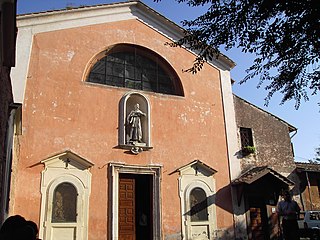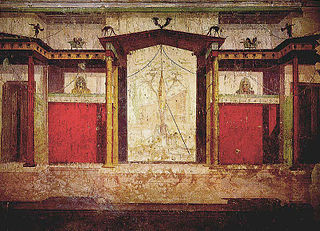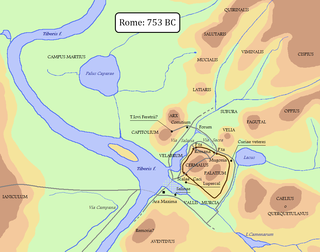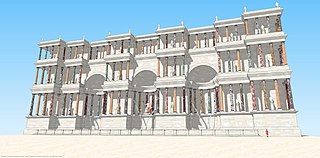 W
WThe Palatine Hill, which is the centremost of the Seven Hills of Rome, is one of the most ancient parts of the city and has been called "the first nucleus of the Roman Empire." The site is now mainly a large open-air museum while the Palatine Museum houses many finds from the excavations here and from other ancient Italian sites.
 W
WVilla Mills, formerly known as Villa Mattei al Palatino, was a villa in Rome located above the Palatine Hill between via di San Bonaventura and via dei Cerchi, in the Campitelli. The structure was built over the Domus Augustana and the Domus Flavia. It was demolished at the beginning of the twentieth century to allow excavations of the archaeological site.
 W
WThe Alexamenos graffito is a piece of Roman graffiti scratched in plaster on the wall of a room near the Palatine Hill in Rome, which has now been removed and is in the Palatine Museum. It may be meant to depict Jesus; if so, it competes with an engraved gem as the earliest known pictorial representation of the Crucifixion of Jesus. It is hard to date, but has been estimated to have been made c. 200. The image seems to show a young man worshipping a crucified, donkey-headed figure. The Greek inscription approximately translates to "Alexamenos worships [his] god," indicating that the graffito was apparently meant to mock a Christian named Alexamenos.
 W
WThe Arch of Titus is a 1st-century AD honorific arch, located on the Via Sacra, Rome, just to the south-east of the Roman Forum. It was constructed in c. 81 AD by the Emperor Domitian shortly after the death of his older brother Titus to commemorate Titus's official deification or consecratio and the victory of Titus together with their father, Vespasian, over the Jewish rebellion in Judaea. The arch contains panels depicting the triumphal procession celebrated in 71 AD after the Roman victory culminating in the fall of Jerusalem, and provides one of the few contemporary depictions of artifacts of Herod's Temple. It became a symbol of the Jewish diaspora, and the menorah depicted on the arch served as the model for the menorah used as the emblem of the state of Israel.
 W
WThe Church of San Bonaventura al Palatino is a small 17th century church building in Rome built on Via Marco Colidio the Palatine Hill. It is a Franciscan monastery church built by Francesco Barberini on the request of the Blessed Bonaventura Gran and was completed in 1689.
 W
WThe Casa Romuli, also known as the tugurium Romuli, was the reputed dwelling-place of the legendary founder and first king of Rome, Romulus. It was situated on the south-western corner of the Palatine hill, where it slopes down towards the Circus Maximus, near the so-called "Steps of Cacus". It was a traditional single-roomed peasants' hut of the Latins, with straw roof and wattle-and-daub walls, such as are reproduced in miniature in the distinctive funerary urns of the so-called Latial culture.
 W
WThe Domus Augustana is the modern name given to the central residential part of the vast Roman Palace of Domitian on the Palatine Hill. In antiquity the name may have applied to the whole of the palace.
 W
WThe Domus Severiana is the modern name given to the final extension to the imperial palaces on the Palatine Hill in Rome, built to the south-east of the Stadium Palatinum in the Domus Augustana of Septimius Severus. It included the Baths of Septimius Severus.
 W
WThe Domus Transitoria was Roman emperor Nero's first palace destroyed by the Great Fire of Rome in 64 AD, and then replaced by his Domus Aurea.
 W
WThe Flavian Palace, normally known as the Domus Flavia, is part of the vast Palace of Domitian on the Palatine Hill in Rome. It was completed in 92 AD by Emperor Titus Flavius Domitianus, and attributed to his master architect, Rabirius.
 W
WThe House of Augustus, or the Domus Augusti, is situated on the Palatine Hill in Rome, Italy. This house has been identified as the primary place of residence for the emperor Augustus.
 W
WThe Lupercal was a cave at the southwest foot of the Palatine Hill in Rome, located somewhere between the temple of Magna Mater and the Sant'Anastasia al Palatino. In the legend of the founding of Rome, Romulus and Remus were found there by the she-wolf who suckled them until they were rescued by the shepherd Faustulus. Luperci, the priests of Faunus, celebrated certain ceremonies of the Lupercalia at the cave, from the earliest days of the City until at least 494 AD.
 W
WThe Palace of Domitian was built as Roman emperor Domitian's official residence in 81-92 AD and was used as such by subsequent emperors. Its remains sit atop and dominate the Palatine Hill in Rome, alongside other palaces.
 W
WRoma quadrata was an area, or perhaps a structure, within the original pomerium of the ancient city of Rome, probably the Palatine Hill with its Palatium and Cermalus peaks and its slopes.
 W
WSanta Lucia in Septisolio was an ancient Roman church with a diaconia. It formerly stood at the base of the Palatine Hill, near the Septizodium of Septimius Severus, from which it took its name. The date of its destruction is not certain, although it seems to have disappeared definitively after the pontificate of Sixtus V (1585–1590).
 W
WThe Septizodium was a building in ancient Rome. It was built in 203 AD by Emperor Septimius Severus. The origin of the name "Septizodium" is from Septisolium, from the Latin for temple of seven suns, and was probably named for the seven planetary deities or for the fact that it was originally divided into seven parts. The building had no known practical purpose and was probably meant to be a decorative façade, known as a Nymphaeum. Ancient and medieval sources describe its purpose as being intended to impress Severus' fellow north Africans as they entered the city, as it was located at the place where the Via Appia passes the Palatine and leads east towards the Forum Romanum. Other examples of septizodia are known, all from Africa.